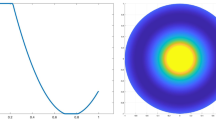Abstract
We explore a typical optimal design problem in 2D conductivity: given fixed amounts of two isotropic dielectric materials, decide how we are to mix them in a 2D domain so as to minimize a certain cost functional depending on the underlying electric field. We rely on a reformulation of the optimal design problem as a vector variational problem and examine its relaxation, taking advantage of the explicit formulae for the relaxed integrands recently computed in Pedregal (2003). We provide numerical evidence, based on our relaxation, that Tartar’s result Tartar (1994) is verified when the target field is zero (also for divergence-free fields) and optimal solutions are given by first-order laminates. This same evidence also holds for a general quadratic functional in the field.
Similar content being viewed by others
References
aler Allaire G (2002) Shape optimization by the homogenization method. Springer, Berlin Heidelberg New York
ArandPed03 Aranda E, Pedregal P (2003) Constrained envelope for a general class of design problems. Discrete Continuous Dyn Syst (Suppl Vol), pp 30–41
BendSig03 Bendsøe MP, Sigmund O (2003) Topology Optimization: Theory, Methods and Applications. Springer, Berlin Heidelberg New York
dacorona Dacorogna B (1989) Direct methods in the calculus of variations. Springer, Berlin Heidelberg New York
goodman Goodman J, Kohn RV, Reyna L (1986) Optimal design problems for two-phase conducting composites with weakly discontinuos objective functionals. Comput Method Appl Mech Eng 57:107–127
gravoski Grabovsky Y (2001) Numerical study of a relaxed variational problem from optimal design. Comput Pure Appl Math 27:683–704
KohnStrang Kohn RV, Strang G (1986) Optimal design and relaxation of variational problems, I, II and III. Adv Appl Math 57:113–137, 139–182, 353–377
li Li YS, Duxbury PM (1989) From moduli scaling to breakdown scaling: a moment spectrum analysis. Phys Rev 40B:4889–4897
Lipton Lipton R, Velo A (2000) Optimal design of gradients fields with applications to electrostatics. In: Cioranescu D, Murat F, Lions JL (eds) Nonlinear partial differential equations and their aplications, College de France Seminar, Chapman and Hall/CRC Research Notes in Mathematics
murat Murat F (1977) Contre-exemples pur divers problèmes où le contrôle intervient dans les coefficients. Ann Mat Pura Appl 4(112):49–68
nelson Nelson JK (1994) Some steps toward the automation of the design of composite dielectric structures. IEEE Trans Dielect Elect Insulat 1:663–671
Pedregal03 Pedregal P (2003) Optimal design in 2-d conductivity for quadratic functionals in the field. In: Proceedings of the NATO advanced workshop in nonlinear homogeneization, Warsaw, pp 229–246
Pedregal04 Pedregal P (2004) Constrained quasiconvexification of the square of the gradient of the state in optimal design. Q Appl Math 6(3):459–470
tartar Tartar L (1994) Remarks on optimal design problems, in calculus of variations, homogeneization and continuum mechanics. Buttazzo G, Bouchitte G, Suquet P (eds) World Scientific, Singapore, pp 279–296
Author information
Authors and Affiliations
Corresponding author
Rights and permissions
About this article
Cite this article
Donoso, A., Pedregal, P. Optimal design of 2D conducting graded materials by minimizing quadratic functionals in the field. Struct Multidisc Optim 30, 360–367 (2005). https://doi.org/10.1007/s00158-005-0521-5
Received:
Revised:
Published:
Issue Date:
DOI: https://doi.org/10.1007/s00158-005-0521-5




